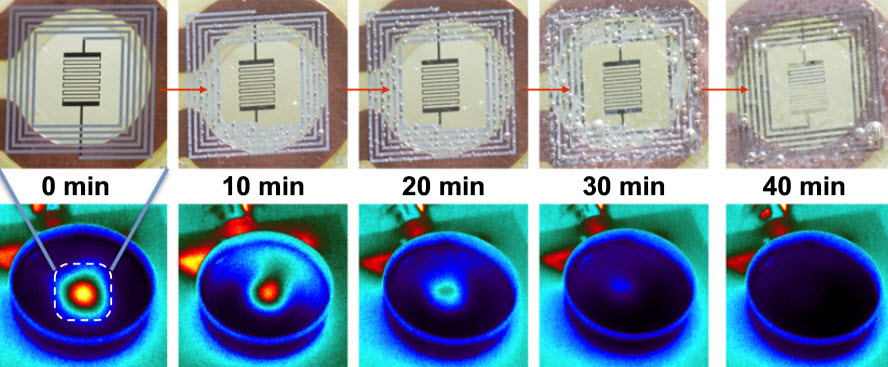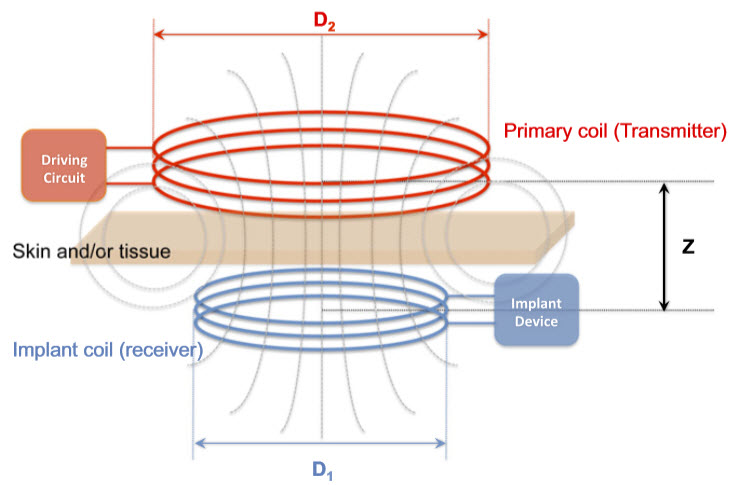Wireless electronic implants deliver antibiotic, then harmlessly dissolve
November 25, 2014

Optical (and corresponding IR) images of the dissolution of implant device (top row: powering induction coil with resistor/heater) (credit: Tufts University)
Imagine an electronic implant that delivers a drug when triggered by a remote wireless signal — then harmlessly dissolves (no post-surgical infection concerns, no fuss, no muss) within minutes or weeks.
That’s what researchers at Tufts University and the University of Illinois at Champaign-Urbana have demonstrated* in mice, using a resistor (as a source of heat for releasing drug and help dissolving the implant) and a power-receiving coil made of magnesium deposited onto a silk protein”pocket” that also protects the electronics and controls its dissolution time.

Schematics of induction coupling between the primary coil and the implanted receiver coil for wireless power delivery (credit: Tufts University)
There have been other implantable medical devices, but they typically use non-degradable materials that have limited operational lifetimes and must eventually be removed or replaced — requiring more surgery.
The research was published online in the Proceedings of the National Academy of Sciences Early Edition the week of November 24–28, 2014. and was supported by the National Institutes of Health and the National Science Foundation.
* Devices were implanted in vivo in S. aureus-infected tissue and activated by a wireless transmitter for two sets of 10-minute heat treatments. Tissue collected from the mice 24 hours after treatment showed no sign of infection, and surrounding tissues were found to be normal. Devices completely dissolved after 15 days, and magnesium levels at the implant site and surrounding areas were comparable to levels typically found in the body. The researchers also conducted in vitro experiments in which similar remotely controlled devices released the antibiotic ampicillin to kill E. coli and S. aureus bacteria. The wireless activation of the devices was found to enhance antibiotic release without reducing antibiotic activity.
Abstract of Silk-based resorbable electronic devices for remotely controlled therapy and in vivo infection abatement
A paradigm shift for implantable medical devices lies at the confluence between regenerative medicine, where materials remodel and integrate in the biological milieu, and technology, through the use of recently developed material platforms based on biomaterials and bioresorbable technologies such as optics and electronics. The union of materials and technology in this context enables a class of biomedical devices that can be optically or electronically functional and yet harmlessly degrade once their use is complete. We present here a fully degradable, remotely controlled, implantable therapeutic device operating in vivo to counter a Staphylococcus aureus infection that disappears once its function is complete. This class of device provides fully resorbable packaging and electronics that can be turned on remotely, after implantation, to provide the necessary thermal therapy or trigger drug delivery. Such externally controllable, resorbable devices not only obviate the need for secondary surgeries and retrieval, but also have extended utility as therapeutic devices that can be left behind at a surgical or suturing site, following intervention, and can be externally controlled to allow for infection management by either thermal treatment or by remote triggering of drug release when there is retardation of antibiotic diffusion, deep infections are present, or when systemic antibiotic treatment alone is insufficient due to the emergence of antibiotic-resistant strains. After completion of function, the device is safely resorbed into the body, within a programmable period.